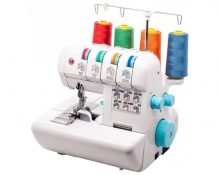An overlocker is a sewing machine whose main function is to overcast edges. This is convenient: the product turns out neat, the edges do not crumble, they become smooth. For proper operation, the overlocker needs to be threaded correctly. How to do it? We'll tell you in the article.

How to thread an overlocker
It is extremely important to position the threads correctly before starting work. Otherwise, skipping stitches cannot be avoided, and the seam may not work out. It is necessary to study the instructions in advance and practice on test patches.
Basic Rules
Almost all models are similar to each other. Differences in brands, price and number of threads involved in the work (there are 3 and 4 thread devices).
Using an overlocker is not difficult if you remember the following rules:
- If you are a beginner seamstress, choose a three-thread device with a speed of no more than 1,500 stitches/minute. It is clear and easy to use.
- Stores often sell devices already threaded. They should be trimmed (it is enough to leave the ends 10-15 cm long).New threads can be tied with a thin knot to the existing ones (it is important to throw them through the thread guide before doing this).
- Before work, check the threads and needles again.
- All refueling work must be carried out strictly with the device unplugged and with the foot raised up.

How to thread a three-thread overlocker
As a rule, modern devices have hints that help you place the threads. We will talk about the standard option:
- Pass the threads sequentially through all the holes that are visible on the body of the device.
- The right looper has a special tension device. Thread the threads there, then draw them down.
- Thread the thread through the eye of the needle.
- Bring the thread behind the foot away from you.
After this, make a stitch on the scrap piece. If everything is correct, it will turn out smooth and neat.
How to thread a four-thread overlocker
This device has two needles, so the filling process will be slightly different. The threads pass through two tension devices - right and left. In this case, the right thread enters the right tensioner, and vice versa.
Modern models of four-thread overlockers are equipped with a special F.A.S.T system with a lever. He moves the loopers towards the threading. Of course, such a mechanism makes the work easier.
How to install a different color thread in an overlocker
Standard situation: you sew pieces of different colors, and the thread has to be changed. You can do this as follows:
- Cut the old thread, place a new one on the spool and tie the ends into a small but strong knot.
- Pull the thread so that the knot is not under the foot.
- Next, you can lift the foot and thread the thread through the fabric.
- Return the presser foot down and continue sewing.
- Now you need to watch the knot: when it approaches the eye of the needle, you should manually carefully help it move through the hole. If the nodule is small, there should be no problems with its passage.

How to set up an overlocker after threading
So, the threads are inserted, you can start sewing. Do not hurry! Now you need to configure the device. It happens that after threading the threads are poorly tensioned. They need to be corrected, otherwise you won’t get straight lines.
Important! While the color of the threads may vary, the thickness and composition do not. At least in one job. It is better to buy threads designed specifically for overlocking in advance.
To understand whether the tension has been optimally selected, set the appropriate controls to the middle position and make a test stitch. If all the stitches are even, the thread runs smoothly and does not get tangled, then everything is fine. If something goes wrong, experiment with the tensioners: loosen or, conversely, strengthen them.
By the way! Once again, we advise you to look at the instructions. Usually there are recommendations for fine-tuning the overlocker.
Common mistakes: how to avoid them
For an overlocker to work properly, it needs to be looked after. Perhaps one of the common mistakes of all craftswomen is neglecting basic operating rules. For example, it is important to constantly clean it of fabric residues, threads and dust, lubricate it regularly and always turn it off after use.
There are other mistakes that even experienced seamstresses sometimes make:
- Rush. It doesn't matter how much time you have. After setting up, you need to check the overlock on a test patch, and then proceed to the main work.
- Wrong choice of needles, spools of thread.For example, it is important that all the needles come from the same package, and on the spools you need to pay attention to the degree of twist.
- Broken needles. This detail is often forgotten, but without it normal work will not work. The needles must be sharp and intact. Don't wait until they break; it's better to replace them early.
It is important to always maintain the product and appliance. Has the line gone to the side? Are the threads tangled? If the overlocker has a knife, you should monitor the movement of the material especially carefully so that the cut edges are perfectly straight.
Threading an overlocker may seem difficult only the first time. Of course, you need skill and basic knowledge of how this device works. But such skills and abilities come with experience.


 0
0





